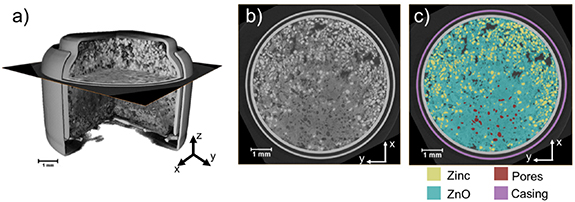In situ x-ray computed tomography of zinc–air primary cells during discharge: correlating discharge rate to anode morphology

Given the urgent need to move to low-carbon technologies, batteries are being increasingly used in a range of applications. Lithium-ion batteries are the most widely used chemistry, but to meet the growing demand, there is a need to move beyond lithium towards alternative battery chemistries. Metal–air batteries are a group of such battery alternatives that hold promise, especially for stationary power and flexible electronics applications.
However, barriers to their widespread adoption include the need to improve their cycling lifetime, as well as stability and avoiding degradation mechanisms such as zinc dendrite growth and hydrogen-producing side reactions. X-ray computed tomography (CT) is a widely used technique for the study of batteries.
